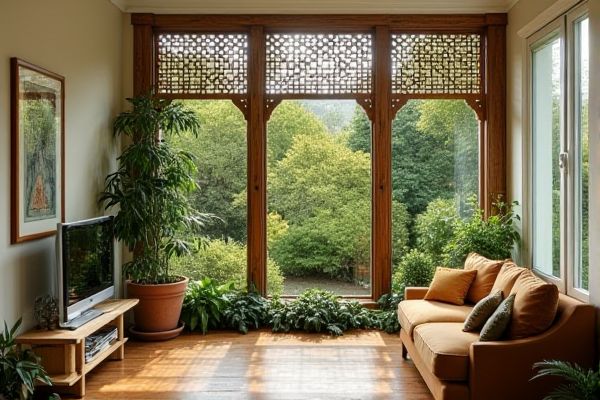
Vertical trellises maximize garden space by encouraging upward plant growth, making them ideal for small areas and climbing vines, while panel trellises offer a decorative and versatile structure that supports various plant types and can act as privacy screens. Discover which trellis style best suits Your garden needs by exploring our detailed comparison in the rest of the article.
Table of Comparison
| Feature | Vertical Trellis | Panel Trellis |
|---|---|---|
| Structure | Upright, single column support | Flat, framed panels for broad coverage |
| Best Use | Climbing plants with vertical growth (e.g., roses, vines) | Privacy screens, large climbing plants, decorative walls |
| Space Efficiency | Minimal footprint, ideal for tight spaces | Requires more ground space due to width |
| Installation | Simple and quick to install | May require additional support and anchoring |
| Material Options | Wood, metal, PVC | Wood, metal, composite materials |
| Durability | Generally durable, depends on material | High durability if well-supported |
| Maintenance | Easy to maintain and clean | Moderate maintenance - may need repainting or repair |
| Aesthetic Appeal | Slim, minimalist design | Broad, decorative surface for visual impact |
Introduction to Trellis Systems
Vertical trellis and panel trellis systems serve distinct roles in garden design by supporting plant growth and enhancing aesthetics. Vertical trellises offer space-saving, upright structures ideal for climbing plants, promoting healthy air circulation and ease of maintenance. Panel trellises provide broader, flat surfaces suitable for spreading vines, creating privacy screens, or decorative garden features that blend functionality with visual appeal.
Defining Vertical Trellis
A vertical trellis is a garden structure designed to support climbing plants by providing an upright framework made of wood, metal, or plastic. It facilitates vertical growth, maximizing space in small gardens or against walls. Unlike panel trellises, which are typically wider and used as screens or borders, vertical trellises prioritize height and direct upward plant expansion.
Understanding Panel Trellis
Panel trellis structures provide a versatile and stable framework for supporting climbing plants, featuring rectangular or square grids made from wood, metal, or vinyl. Unlike vertical trellis designs that emphasize height and linear support, panel trellises offer broad surface areas ideal for training vines horizontally and creating decorative garden screens. Your choice of a panel trellis enhances both plant growth and garden aesthetics by combining strength with easy installation and flexible design options.
Key Structural Differences
Vertical trellises feature upright, linear supports that maximize vertical growing space and are ideal for climbing plants requiring height. Panel trellises consist of flat, grid-like structures offering broader lateral support, making them suitable for spreading vines or shrubs. Understanding these key structural differences helps you select the right trellis to optimize plant growth and garden design.
Material Comparison
Vertical trellises are typically made from durable, weather-resistant materials such as cedar, redwood, or vinyl, offering strength and longevity for climbing plants. Panel trellises often use lattice wood or metal frames with interwoven panels, providing flexibility in design but sometimes compromising on sturdiness. Your choice should consider the balance between aesthetic appeal and material durability to ensure the trellis withstands environmental conditions while supporting plant growth effectively.
Installation Requirements
Vertical trellises require secure ground anchoring or wall mounting to support upward plant growth, necessitating sturdy posts or brackets for stability. Panel trellises often demand broader installation spaces, involving multiple connection points for each panel and sometimes the use of heavy-duty fasteners to maintain rigidity. Both types may require soil preparation or structural reinforcement depending on plant weight and environmental exposure.
Space Utilization and Design
Vertical trellises maximize space utilization by allowing plants to grow upward, making them ideal for small gardens or narrow spaces. Panel trellises offer a broader surface area, perfect for creating garden partitions or decorative focal points with climbing plants. Your choice depends on whether you prioritize efficient use of limited space or a more expansive design element.
Plant Compatibility
Vertical trellises are ideal for climbing plants like clematis, jasmine, and pole beans that require upward support to maximize sunlight exposure and air circulation. Panel trellises work well for vining plants such as grapevines and cucumbers, offering a broader surface area for spreading and training growth horizontally. Both structures enhance plant health by preventing overcrowding and promoting vigorous development tailored to specific plant growth habits.
Pros and Cons Analysis
Vertical trellises optimize vertical space, making them ideal for small gardens and climbing plants like beans and peas, but they may limit airflow and sunlight penetration. Panel trellises provide a broader surface area, supporting heavier or sprawling plants such as clematis and roses, yet they require more horizontal space and can dominate the visual aesthetic of a garden. Choosing between vertical and panel trellises depends on plant type, available space, and desired garden design.
Choosing the Right Trellis for Your Garden
Vertical trellises maximize space by encouraging plants like cucumbers and beans to grow upward, ideal for small gardens or limited ground area. Panel trellises provide a broad, sturdy surface suitable for climbing roses, clematis, and other flowering vines, enhancing garden aesthetics and supporting heavier plants. Selecting the right trellis depends on plant type, garden size, and desired visual impact to ensure healthy growth and optimal use of space.
 homyna.com
homyna.com